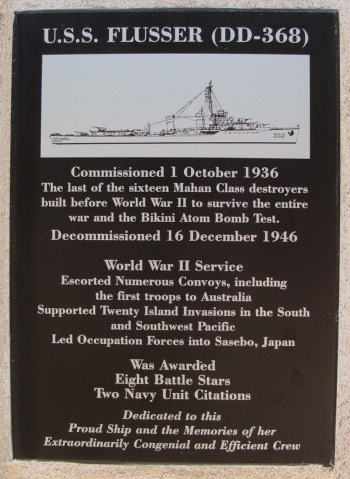The Destroyer U.S.S. Flusser DD368: Her Life of Service
by E. Byron Dennis
Privately published, 1989, 86 pages
The destroyer U.S.S. Flusser (DD-368) successfully fought against
several attacking kamikaze aircraft in the Philippines during November and
December 1944, but the ship luckily escaped any serious damage. Former officers
and crewmen contributed to this privately published soft cover history of
Flusser, which served as a US Navy ship for ten years from her
commissioning in 1936 to her decommissioning in 1946.
Author E. Byron Dennis, who served aboard Flusser from January
1942 to April 1945, assembled and published this ship history based on his
contacts at annual reunions of the U.S.S. Flusser (DD-368) Association,
which was formed in 1983. Although the author states that he wrote the book based
on contributions from Flusser veterans, the text has relatively few
personal incidents and almost no names to identify sources of the few stories. The book
also has no bibliography or summary of sources used. In some places the history
starts to become a dry recitation of facts due to the lack of personal stories.
The last part of the book devotes over 20 pages to US ships lost in WWII, which
has little direct relationship to Flusser's history.
The book includes a couple of interesting newspaper articles about the ship,
whose nickname was Frustrate due to lack of battle action through the
middle of 1944. Flusser was based in Pearl Harbor at the time of the
Japanese attack on December 7, 1941, but the destroyer missed the attack since
on that date she was screening the carrier Lexington (CV-2) away from
base. The February 1943 Herald Tribune article entitled "U.S.S.
Frustrate: Fighting Ship Vainly Seeking Action in the Pacific" describes the
class of ship to which Flusser (actual name not in article) belonged up
to that time (p. 17):
There is a third class of ships in the Pacific Fleet, and they are
entitled to both admiration and sympathy. They are the frustrated ones. They
neither sink nor are they sunk. They venture forth to battle and the enemy
flees. Or they smash into a nest of torpedoes and dive-bombers and escaped4
unscathed. These frustrated ships consider they are unlucky. The enemy comes
and the enemy goes, but nothing ever happens to them.
A 19-year-old Flusser crewman, quoted in a June 1944 San Francisco
News article entitled "U.S.S. Frustrate Still Looking For Crack
at Jap of Her Own," did not seem to mind his ship's nickname (p. 22):
This ship is really charmed. We have been through a great deal of action
but never have been scratched. We have been all through the South Pacific.
We have lobbed many a shell ashore at Jap batteries, hidden in the jungle,
but we have never seen a Jap warship under way. All that we have seen had
been hit already by other members of our fleet.
The charmed destroyer found plenty of action soon after publication of this
June 1944 newspaper article.
Flusser had her first close call on September 7, 1944, when shore
batteries on Wotje Island in the Marshall Islands opened fire on the destroyer.
Several projectiles exploded near the ship wounding eight men with shrapnel and
causing some minor damage. The destroyer arrived off Tacloban on Leyte Island on
October 29, 1944, and the ship served in the Philippines for most of the rest of
the Pacific War. Flusser, as flagship of Destroyer Squadron Five, soon
saw action on November 1, 1944, as multiple kamikaze aircraft attacked the
American fleet off Leyte. Although the book provides few details regarding Flusser's
actions on that date, it does mention that the ship's sonar heard the breaking
up of the destroyer Abner Read (DD-526) as she sank after being hit by a
kamikaze.
The second close call came when a kamikaze Zero fighter nearly hit Flusser
as described below (pp.30-1):
On 18 November 1944 the Flusser, with various other men-of-war and
supply ships, was anchored off the beach at Leyte when a flight of Kamikazes
was observed approaching the anchorage. Some hits were made on anchored
supply ships when one of three Zero fighters circling the ships made a pass
directly across the Flusser's bow at a 45 degree elevation. He
suddenly made a sharp turn to the right and started diving directly at the
bridge of the ship. Lieut. Cmdr. Vogeley, the Commanding Officer, was
standing on the port wing of the bridge observing the plane with binoculars
when the pilot was hit by the forward 20 millimeters and knocked to the
other side of the cockpit, apparently pulling the stick with him. With no
more than a few feet to spare, the wing of the airplane passed over the
C.O.'s head and crashed close aboard the port side, so close in fact that
his parachute fell on the bow and various other parts rained down all over
the ship. The curiosity was, why the parachute? Obviously he had no need of
it.
Flusser also participated in the fiercely fought Battle of Ormoc Bay on
December 7, 1944, in order to land Allied troops at Ormoc with the objective of
severing Japanese defenses on Leyte Island. The destroyer expended all of her
ammunition that day as she came under almost constant air attacks for ten hours.
A suicide plane crashed into the destroyer Lamson (DD-367), killing 21
and wounding 50. Flusser picked up survivors and escorted the severely
damaged ship back into Leyte Gulf as she came under heavy air attack. That day
kamikaze aircraft also hit and sunk the high speed transport Ward
(APD-16) and the destroyer Mahan (DD-364).
This history's lack of personal stories and few details concerning Flusser's
role in key battles in which she participated make this book of limited appeal
to readers not directly associated with Flusser.

Flusser Memorial Plaque at
National Museum of the Pacific War
(Fredericksburg, Texas)
|